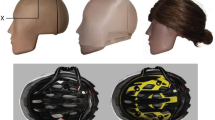Abstract
The hitting of titanium head golf driver against golf ball creates a short duration, high frequency impact noise. We analyzed the spectra of these impact noises and evaluated the auditory hazards from exposure to the noises. Noises made by 10 titanium head golf drivers with five maximum hits were collected, and the spectra of the pure impact sounds were studied using a noise analysis program. The noise was measured at 1.7 m (position A) and 3.4 m (position B) from the hitting point in front of the hitter and at 3.4 m (position C) behind the hitting point. Average time duration was measured and auditory risk units (ARUs) at position A were calculated using the Auditory Hazard Assessment Algorithm for Humans. The average peak levels at position A were 119.9 dBA at the sound pressure level (SPL) peak and 100.0 dBA at the overall octave level. The average peak levels (SPL and overall octave level) at position B were 111.6 and 96.5 dBA, respectively, and at position C were 111.5 and 96.7 dBA, respectively. The average time duration and ARUs measured at position A were 120.6 ms and 194.9 units, respectively. Although impact noises made by titanium head golf drivers showed relatively low ARUs, individuals enjoying golf frequently may be susceptible to hearing loss due to the repeated exposure of this intense impact noise with short duration and high frequency. Unprotected exposure to impact noises should be limited to prevent cochleovestibular disorders.


Similar content being viewed by others
References
Henderson D, Hamernik RP (1986) Impulse noise: critical review. J Acoust Soc Am 80:569–584
Clark WW (1991) Noise exposure from leisure activities: a review. J Acoust Soc Am 90:175–181
Schwetz F, Raber A, Neuberger M, Körpert K, Bauer P (1992) Impact noise and hearing. A study from audiometry screening in noisy occupational environments. HNO 40:10–15
Buchanan MA, Wilkinson JM, Fitzgerald JE, Prinsley PR (2007) Is golf bad for your hearing? BMJ 337:a2835
Price GR (2005) A new method for rating hazard from intense sounds: implications of hearing protection, speech intelligibility, and situation awareness. In: Larkin WD, Dancer A, Buck K (eds) New directions for improving audio effectiveness, Amersfoort, Netherland, April 11–13. Research and Technology Organisation (NATO), Neuilly-sur-Seine, p KN2-1
Ryu JK, Jeon JY, Kim HS (2005) Development of noise annoyance scale and criteria of residential noises through auditory experiments. Trans KSNVE 15:904–910
Price GR (2007) Predicting mechanical damage to the organ of Corti. Hearing Res 226:5–13
Konopka W, Pawlaczyk-Luszczynska M, Sliwinska-Kowalska M, Grzanka A, Zalewski P (2005) Effects of impulse noise on transiently evoked otacoustic emission in soldiers. Int J Audiol 44:3–7
Action WI, Coles RRA, Forrest MR (1968) Hearing hazard from small-bore rifles. J Acoust Soc Am 44:817–818
Price GR (2007) Validation of the auditory hazard assessment algorithm for the human with impulse noise data. J Acoust Soc Am 122:2786–2802
Chan PC, Ho KH, Kan KK, Stuhmiller JH, Mayorga MA (2001) Evaluation of impulse noise criteria using human volunteer data. J Acoust Soc Am 110:1967–1975
Henderson et al (2010) Noise-induced hearing loss: implication for tinnitus. In: Aage RM, Berthold L, De Dirk R, Tobias K (eds) Textbook of tinnitus. Springer, New York, pp 301–309
Ylikoski J (1988) Delayed endolymphatic hydrops syndrome after heavy exposure to impulse noise. Am J Otol 9:282–285
Wu CC, Young YH (2009) Ten-year longitudinal study of the effect of impulse noise exposure from gunshot on inner ear function. Int J Audiol 48:655–660
Schmuzigert N, Fostiropoulos K, Probst R (2006) Long-term assessment of auditory changes resulting from a single noise exposure associated with non-occupational activities. Int J Audiol 45:46–54
Clifford RE, Rogers RA (2009) Impulse noise: theoretical solutions to the quandary of cochlear protection. Ann Otol Rhinol Laryngol 118:417–427
Acknowledgments
This work was supported by the grant number 0420100560 from Seoul National University Hospital Research Fund and a clinical research grant from Seoul National University Boramae Medical Center.
Conflict of interest
None.
Author information
Authors and Affiliations
Corresponding author
Rights and permissions
About this article
Cite this article
Kim, Y.H., Kim, Y.C., Lee, J.H. et al. Analysis of impact noise induced by hitting of titanium head golf driver. Eur Arch Otorhinolaryngol 271, 2885–2890 (2014). https://doi.org/10.1007/s00405-013-2781-9
Received:
Accepted:
Published:
Issue Date:
DOI: https://doi.org/10.1007/s00405-013-2781-9




